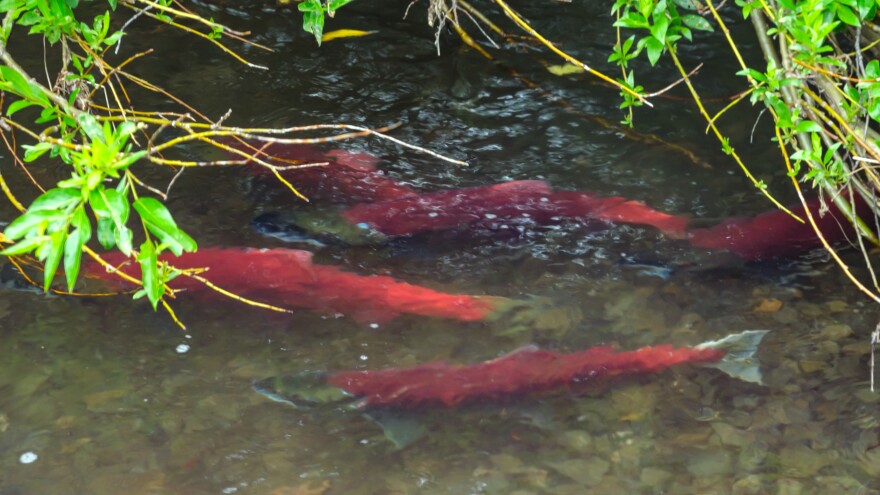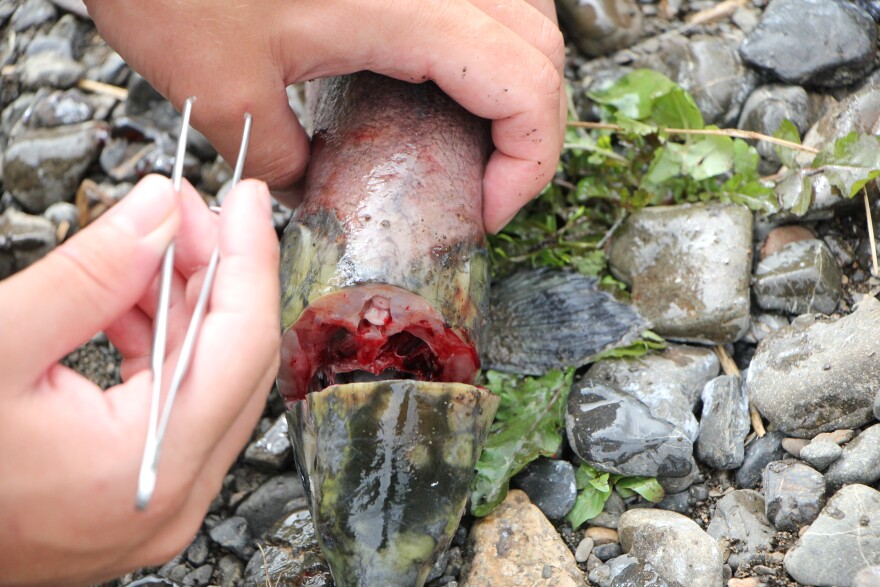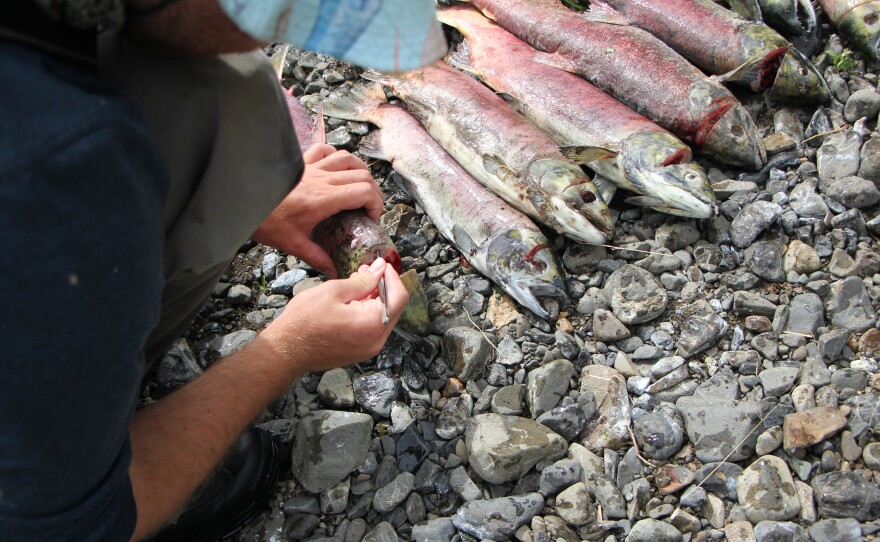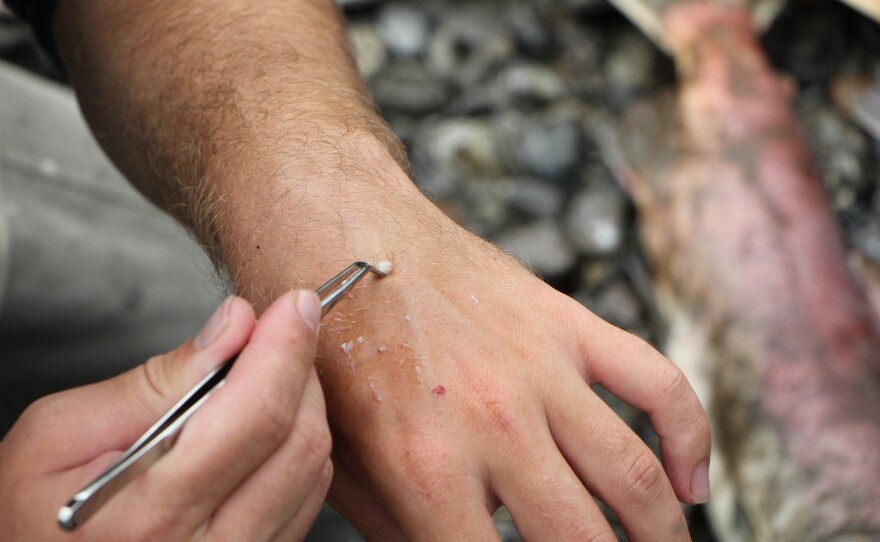In the summer, hordes of salmon travel thousands of miles from the ocean to fill the streams and creeks around Lake Aleknagik. These waterways are an important part of the salmon life cycle, where adult fish come to spawn and then die.
The fish aren’t the only ones in these waters. Each year, researchers from the University of Washington’s Alaska Salmon Program follow them upstream to survey the number of salmon that reach these spawning grounds.
On a cool, cloudy day in early August, Jackie Carter, a research scientist with the program, headed out with two university technicians to collect samples from the salmon. After crossing Lake Aleknagik in a skiff, the opening of Yako Creek came into view. Piles of fish thrashed and jumped in the shallow water.
The heavy, foul smell of rotting salmon hit immediately, and skeletons lined the shore. Carter said the researchers count all the fish, dead or alive.
"We literally have clickers in each hand and we walk and we click: Male, female, male, male, male, female, male," she said.
Despite the copious clicking, she said her thumbs didn't get sore.
"Your brain gets sore. Your thumbs can handle it better than your brain can," she said.
According to Carter, researchers from the university have been coming up to Aleknagik every summer since 1946 to collect data on these streams. The salmon counts usually peak between Aug. 2 and Aug. 7, so the researchers aim to do most of their surveying in the middle of that period, on Aug. 5.
They count the salmon and collect data on the fish, including how much time they spent in fresh water and the ocean. More recently, the team has also been recording how the fish die —whether they deteriorated on their own or were killed by predators.
Carter said that by early August she could already tell this year’s count would be high. But the population can vary substantially from year to year. The scientists don’t use their research for advocacy work, she said. Instead, they want relevant data to inform current debates around development in the larger Bristol Bay watershed.
"With the whole Pebble Mine thing, we can use these data to say, ‘Well look — these things are really variable,’" she said. "You can’t just look at one year and say, ‘Hey, this is a good place to spawn, let’s protect this,’ or, ’There’s no fish here, let’s do whatever we want.’ So our long-term data really shows that things go up and down and up and down, and that is a valuable component of the ecosystem and keeps the whole ecosystem functioning."
On the day Carter and the technicians were at Yako Creek, there were so many sockeye that it was difficult to walk through the water without accidentally kicking them. For most of their lives, these salmon are silver, but as they move through freshwater streams, they begin to decay.

They don’t eat in fresh water when they return from the ocean. Instead they use the energy stored in their bodies to travel to the spawning grounds. In the process, the salmons’ skin turns red and deteriorates. Their drive is to spawn before they die, but some of them don’t make it long enough to lay eggs. Dead fish were all over the creek bed. A fallen tree branch was covered in carcasses, like dust collected over time.
Those dead fish are just as important as the live animals. Carter explained that they bring nutrients from the ocean into this stream ecosystem.
"The important nutrients are the carbon and the nitrogen. And that then gets into the terrestrial system," she said. "It feeds the bears, it feeds the birds. You can find signals of marine nutrients in basically everything: trees, grass."
Carter grabbed a few dead fish and threw them onto the bank of the stream.
Another part of her work is to record the history of the salmons’ lives, like how long they spent in each body of water. The researchers do this by studying a tiny ear bone inside the salmons' heads, called an otolith. Carter picked up a fish in one hand and a knife in the other. She sawed open its head, revealing the dead brain inside.
From there, she used tweezers to gently pry out the otolith and wipe it clean. It was a thin sliver of bone that looked incredibly fragile. Up close, a series of light and dark rings were visible on the bone. Carter said the rings show how many years the adult salmon spent in fresh water and how many years it lived in salt water after that.
After cutting open a few more heads and storing the otoliths in sample jars, the team returned to the research camp. The next day, they would be back for more data collection.
When she and the team return to Seattle, they analyze the otoliths under microscopes and add their data to the years of research — nearly eight decades of it — that provide the foundation for understanding Bristol Bay’s salmon population.
Counting and cutting up decaying fish may not be for everyone, but Carter and the technicians think the job is pretty great.

Get in touch with the news team at news@kdlg.org or 907-842-2200.








